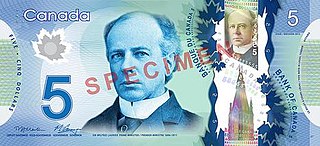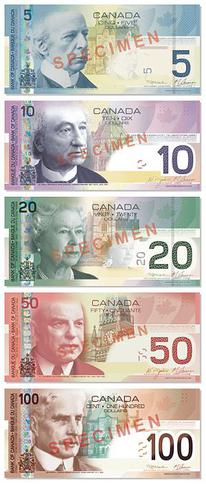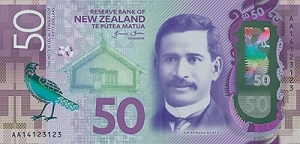Federal Reserve Notes, also United States banknotes, are the currently issued banknotes of the United States dollar. The United States Bureau of Engraving and Printing produces the notes under the authority of the Federal Reserve Act of 1913 and issues them to the Federal Reserve Banks at the discretion of the Board of Governors of the Federal Reserve System. The Reserve Banks then circulate the notes to their member banks, at which point they become liabilities of the Reserve Banks and obligations of the United States.

The pound sterling is the official currency of the United Kingdom, Jersey, Guernsey, the Isle of Man, British Antarctic Territory, South Georgia and the South Sandwich Islands, and Tristan da Cunha.

The Mauritian rupee is the currency of Mauritius. One rupee is subdivided into 100 cents. Several other currencies are also called rupee.

Moraine Lake is a snow and glacially fed lake in Banff National Park, 14 kilometres (8.7 mi) outside the village of Lake Louise, Alberta, Canada. It is situated in the Valley of the Ten Peaks, at an elevation of approximately 1,884 metres (6,181 ft). The lake has a surface area of 50 hectares.

The Canadian five-dollar note is the lowest denomination and one of the most common banknotes of the Canadian dollar.

The Fijian dollar has been the currency of Fiji since 1969 and was also the currency between 1867 and 1873. It is normally abbreviated with the dollar sign $, or alternatively FJ$ to distinguish it from other dollar-denominated currencies. It is divided into 100 cents.

The Canadian fifty-dollar note is one of the most common banknotes of the Canadian dollar. It is sometimes dispensed by ATMs but not as commonly as the $20 note.

The Canadian one-hundred-dollar note is one of five banknotes of the Canadian dollar. It is the highest-valued and least-circulated of the notes since the thousand-dollar note was gradually removed from circulation starting in 2000.

Banknotes of the Canadian dollar are the banknotes or bills of Canada, denominated in Canadian dollars. Currently, they are issued in $5, $10, $20, $50, and $100 denominations. All current notes are issued by the Bank of Canada, which released its first series of notes in 1935. The Bank of Canada has contracted the Canadian Bank Note Company to produce the Canadian notes since then. The current series of polymer banknotes were introduced into circulation between November 2011 and November 2013. Banknotes issued in Canada can be viewed at the Bank of Canada Museum in Ottawa.
Scenes of Canada is the fourth series of banknotes of the Canadian dollar issued by the Bank of Canada. It was first circulated in 1970 to succeed the 1954 Canadian Landscape series and was followed by the 1986 Birds of Canada banknote series. This was the last series to feature a $1 bill, which was replaced by a $1 coin known as the loonie in 1987, although both the $1 bill and the loonie were produced concurrently for 21 months, from June 1987 to April 1989.

The New Zealand twenty-dollar note is a New Zealand banknote. It is issued by the Reserve Bank of New Zealand and since 1999 has been a polymer banknote. It was first issued on 10 July 1967 when New Zealand decimalised its currency, changing from the New Zealand pound to the New Zealand dollar. It has an image of Queen Elizabeth II on the front.

Canadian Journey is the sixth series of banknotes of the Canadian dollar designed and circulated by the Bank of Canada. It succeeded the 1986 Birds of Canada banknote series. The first banknote of the Canadian Journey series issued into circulation was the $10 bill on 17 January 2001, and the last to be issued was the $50 bill on 17 November 2004. The series was succeeded by the 2011 Frontier Series, the banknotes of which were first issued into circulation from 2011 to 2013.
New Zealand dollar banknotes are the banknotes in circulation in New Zealand, the Cook Islands, Tokelau, Niue and the Pitcairn Islands, denominated in the New Zealand dollar. They are issued by the Reserve Bank of New Zealand and since 1999 have been made of polymer.

Birds of Canada is the fifth series of banknotes of the Canadian dollar issued by the Bank of Canada and was first circulated in 1986 to replace the 1969 Scenes of Canada series. Each note features a bird indigenous to Canada in its design. The banknotes weigh 1 gram with dimensions of 152.40 by 69.85 millimetres. It was succeeded by the 2001 Canadian Journey series.

The New Zealand five-dollar note is a New Zealand banknote. It is issued by the Reserve Bank of New Zealand and since 1999 has been a polymer banknote. It was first issued on 10 July 1967 when New Zealand decimalised its currency, changing from the New Zealand pound to the New Zealand dollar. The note originally had an image of Queen Elizabeth II on the front; since 1992 it has had an image of Sir Edmund Hillary. The new design released in October 2015 was named "Banknote of the Year" by the International Bank Note Society for 2015.

The New Zealand ten-dollar note is a New Zealand banknote. It is issued by the Reserve Bank of New Zealand and since 1999 has been a polymer banknote. It was first issued on 10 July 1967 when New Zealand decimalised its currency, changing from the New Zealand pound to the New Zealand dollar. The ten-dollar note originally had an image of Queen Elizabeth II on the front; since 1993 it has had an image of suffragist Kate Sheppard.

The New Zealand fifty-dollar note is a New Zealand banknote. It is issued by the Reserve Bank of New Zealand and since 1999 has been a polymer banknote. It was first issued in 1983. The note originally had an image of Queen Elizabeth II on the front; since 1992 it has had an image of Sir Āpirana Ngata.

The New Zealand one-hundred-dollar note is a New Zealand banknote. It is issued by the Reserve Bank of New Zealand and since 1999 has been a polymer banknote. It was first issued on 10 July 1967 when New Zealand decimalised its currency, changing from the New Zealand pound to the New Zealand dollar. The note originally had an image of Queen Elizabeth II on the front; since 1992 it has had an image of Ernest Rutherford.

The Frontier series is the seventh series of banknotes of the Canadian dollar released by the Bank of Canada, first circulated in 2011. The polymer banknotes were designed for increased durability and to incorporate more security features over the preceding 2001 Canadian Journey series. The notes feature images that focus on historic Canadian achievements and innovation. Printed on polymer, the 2011 Frontier series was the first series issued by the Bank of Canada printed on a material other than paper. The 2011 Frontier series was followed by the 2018 series.

The Bank of England £20 note is a sterling banknote. It is the second-highest denomination of banknote currently issued by the Bank of England. The current polymer note, first issued on 20 February 2020, bears the image of Queen Elizabeth II on the obverse and the image of painter J. M. W. Turner on the reverse. It replaced the cotton paper note featuring a portrait of economist Adam Smith, first issued in 2007.















